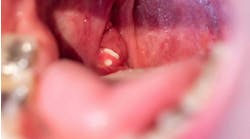Several single-dose options are available for easing the minor pain of patients. Administering a topical anesthetic solution or gel may be just the relief an edgy patient needs. Most dentists have encountered the patient who, during a routine visit, insists on being topically numbed before an instrument is even placed in his or her mouth. One should notice the patient immediately relaxing following the first swipe of topical anesthetic. With the onset of mucosa numbness, one may even notice a shallow sigh as the patient expels the breath he or she has been unconsciously holding.
Benzocaine is the active ingredient most commonly found in topical gels. Lidocaine and prilocaine are used when a subgingival application is the mode. Plunging the cotton applicator deep into the thick ointment may be gratifying for some, but retrieving from the tip of the jar lends itself to a glob of topical that may be messy and hard to measure. Benzocaine metabolizes quickly, so one should anticipate a window of “numbing” opportunity ranging from a few minutes to more than half an hour, depending on application, metabolism, and saliva flow.
Pre-measured dosage units is currently a hot topic-al. Because products are delivered in individual packages, they offer chairside convenience and no mess. HandiCaine Stix by Sultan Dental Products is an example of this type of product. A cotton applicator measuring 3½ inches rests in a sealed reservoir, and is coupled with a well filled with flavored topical. The container is ideal for aseptic chairside tray setups and works well for multiple applications (same patient) without risk of cross contamination.
HandiCaine is a 20 percent pre-measured benzocaine gel that comes with 24 single dose or 120 units per purchase. When hygiene procedures call for quick comfort, HandiCaine comes in handy. The used applicator and empty plastic well, along with other operatory disposables, can be disposed of after each procedure.
Another 20 percent benzocaine product in a unit dose is the Lollicaine by Centrix Dental. This product is similar to a lollipop. However, this anesthetic dose has a cotton applicator and an easy open seal, unlike the tightly twisted wrappers found on suckers. Lollicaine comes in three flavors - Very Cherry, Wonderful Mint, and Pina Koolada. There is no bitter aftertaste, and rapid numbness can be expected. At four inches, the cotton swab is long enough to easily reach the posterior areas, as well as to maneuver the anterior with enough gel to coat at least two hefty swabs full of oral topical.
Another benefit of disposable packaging is the improvement for asepsis. Cross contamination, a possibility with multi use jars, is eliminated with the single use unit. When the gel is tinted, it is easier to see how much topical is being placed prior to absorption. Generally, enough topical is supplied in a single dose applicator to comfortably control most hygiene needs, whether as a pre-application to injection, to ease the discomfort of scaling, or to coat minor irritations. Beutlich Pharmaceuticals, makers of Hurricaine topical since the 1950s, also offer a single dose topical. This comes in a dry handle type swab supplied in a 100-count box. Because it is a 20 percent benzocaine formula, rapid onset for quick pain relief should be expected.
An alternative to a topical gel is an oral pain reliever, which is pre-filled fluid in a dosed stick. CaineTips by J. Morita is a pre-measured dosage that is individually plastic wrapped. This 20 percent benzocaine does not drip because it fully saturates the tip. With a bend and a snap of the ring-striped cotton application end, the numbing solution flows down the clear tube and moistens the opposite end, which also has a cotton applicator. This type of product reduces the chances that the topical will become globbed in one spot, so it can be evenly distributed. Simply swab the tissues for precise placement. CaineTips come in boxes of 100 individual clear wrapped swabs.
Many dental offices apply topical anesthetic prior to the “poke.” Topicals have proven safe and effective for many hygiene procedures. Single dosing methods of 20 percent benzocaine, an amide, have shown minute allergy concerns. When applying topical, keep in mind that salivary fluids wash it away, so it may become difficult to gauge how long the topical will provide relief. Reapplication may be needed for those with heavy salivary flow. Topicals applied from a single dose generally supply enough gel to provide comfort during a patient’s single sitting. Lobbing a loaded swab onto the tissues is messy, and it’s good practice to apply the relieving agents only to the area being worked on. Otherwise, the patient may swallow excess topical and develop a numb throat.
The author did not receive compensation for product endorsements. For more on this topic, visit online www.sultandental.com, www.centrixdental.com, www.beutilich.com, www.jmori tausa.com.
Karen Kaiser, RDH, graduated from St. Louis’ Forest Park dental hygiene program in 1994 and currently practices at the Center for Contemporary Dentistry in Columbia, Ill. She has written several articles for RDH and other publications, sits on dental hygiene panels, and is an evaluator for Clinical Research Associates. She can be contacted at [email protected].





